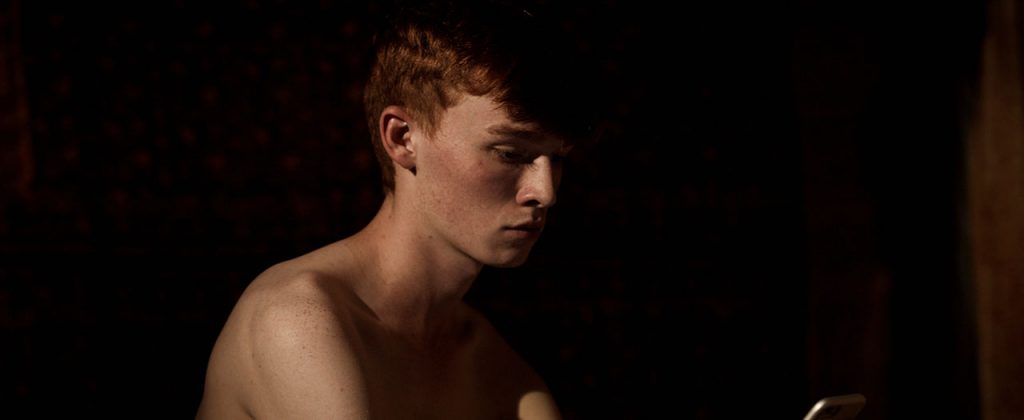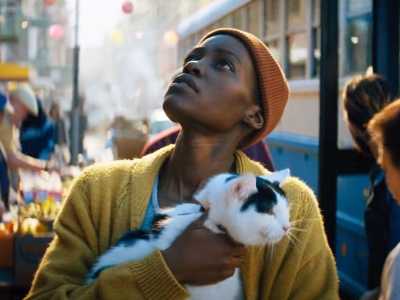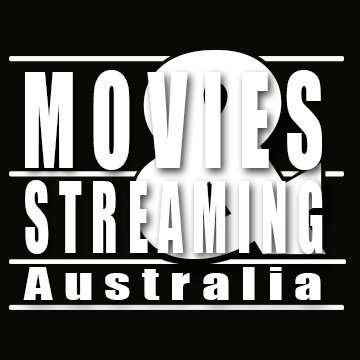AFTRS graduate Samuel Van Grinsven emerges with a stylish and accomplished first-time feature with the erotic story of 16-year-old student Sequin (newcomer Conor Leach), who is exploring his burgeoning sexuality through an obsession with anonymous, no-strings sexual encounters. Distant to those around him, one night at a sex party the boy develops an attraction to a mysterious stranger, while also becoming the object of another man’s obsession.
Born in New Zealand and raised in Australia, Samuel Van Grinsven has directed both independent theatre and film. With a focus on queer voices, Van Grinsven aims to create contemporary work that reflects the complexity of his community. In 2017, Van Grinsven began a Master of Arts Screen at AFTRS with a research area focused on the New Queer Cinema movement. His work has screened at film festivals both domestically and internationally. Sequin in a Blue Room is his debut feature.

I met up with director Samuel Van Grinsven, to ask him a few questions ahead of the international premiere at OutFest in Los Angeles.
Did you do any research in regards of the story behind the character Sequin?
Sequin is based on some of my own experiences, but also Jory (Anast) and I interviewed people in our age group who grew up in Australia around the same time and there’s just a huge amount of common experiences of being queer in Australia. Also, the process of coming of age, growing up quicker than the people around you, putting yourself in dangerous situations in order to have sexual discovery and a complete reliance on social media to a certain degree. The process of coming out while accepting your sexuality and meeting other queer people, because not a lot of people come out, especially where I grew up in conservative Queensland. A lot of the first queer people we “met” were online, living in other countries, who were older than us or sometimes around the same age. That became a huge part of the film, that generational divide.
You mentioned that you co-wrote the film with Jory Anast, who’s based in LA. What challenges do you come across when working on the same project, being on different continents and different time zones?
Especially time-zone wise it’s hard. Our Skype-sessions go for like four or five hours and are really intense. We’re doing it again right now. I think the only reason it works, is because we grew up together. We met each other when we were seventeen. The first thing I ever directed was a theatre play and she wrote that. She was the one who recommended that I start going into film and not theatre. I then got into film school. She’s been such a huge part of my life in film. She’s basically the reason behind everything. So, when I knew I was going to make my first feature film, I started writing it by myself and I knew I wanted to work with someone. I tried to work with someone in Australia, because logistically it would be so much easier, but it just didn’t work. I needed someone I could be completely open with, someone who would understand that it’s personal to me. It’s my favourite collaborative relationship. She’s just phenomenal.
Do you think it’s important to also have a little bit of a female point of view on what you’re working on, although Sequin in a Blue Room has a male perspective?
The first draft used a lot more “male gay language”. There were certain things that my co-writer didn’t really understand, why Sequin was doing certain things in particular scenes. It gave that “outsider” perspective, since there’s experiences in the film that she hadn’t gone through as a woman. She was able to shape it, so that a female audience can watch it and say, “I had a similar experience”. We had reactions like that from test audiences, which has been very touching and special. Even though it’s a very masculine dominant film.

How was it working with Conor Leach (Sequin), since this was his debut on screen?
He’s done theatre before, but he had never been in front of a camera. It was very easy, we worked really well together. He brought something to the role which I didn’t expect. I think I ended up casting a different Sequin to what I wanted, a better one. In his audition tape, which was a self-tape, he chose a monologue that became the version of Sequin he ended up playing in the film. He brought this manipulative side out of Sequin, he’s very socially smart. Conor is so often three steps ahead of everyone else he’s speaking to. That quiet confidence. He doesn’t need to use his words, and that really helped the script, because it’s a very minimal dialogue film. That was something we were terrified of, since Australian films are so dialogue heavy. We were scared of that in the casting process, in terms of finding someone who could pull this off, the close ups without dialogue. Conor could do it. Two lines into his self-tape, I never watched the whole thing, I knew that he was right, and we flew him to Sydney. He transformed the character. Even on set, we were able to drop lines because we didn’t need them, he was doing it. And that’s why so much of the film is a close-up.
On the other hand, you do use a hook-up app, which is also a very important part of the film and basically its own character. In my opinion used in a very different and better way than most films or tv-series do. The use of social media on screen is very transparent and not in your face. How hard was it for you to incorporate that aspect of the story and use it in the correct way without pulling you out of the story?
There was a lot of audience testing in all stages of production. Screenplays are so strict – how do you incorporate that into a screenplay? How do we write it in a way people aren’t going to get confused and still have it work on screen? In production, it was very strange on set. So many shots are just of Sequin looking at his phone. We have this weird amount of room on screen. Especially crew, who are dropping in for a few days, who haven’t read the screenplay would go like “What the hell is going on here?!”. That was very much this relationship between me and Conor, and constantly having conversations as in “do you think it would take that long to reply?” or “why does he take this long to reply?”. It is such an important part of Sequin’s life, what causes a genuine human face reaction and what doesn’t? Big part of all of these scenes in production was “speed”. We could make the film for people in our generation, who can read text on screen very quickly, but then we’d be discounting a huge older audience. Conor would do two to three takes – all in different speeds. This would cause for a lot of re-writing as well, in post-production. Lots of conversations were quite long and we would cut them down. Especially also more queer slang that might be new to straight audiences, how did test audiences react to this and could they keep up with it? There are no rules on this kind of cinema – yet – so it was fun to do something different and new.
Did you feel the need to label your film, in a time where more and more people in the LGBTQ+ community don’t want to be associated with labels anymore?
Greg Araki’s New Queer Cinema-trilogy opens every film with a different label – a homo film, a heterosexual film and an irresponsible film. It was important for me to reference that time period of cinema, but specifically the three pieces of work which were a huge influence for this film. The other side of it is, in the world of Sequin, labels are still important. Socially we’re moving away from them, but on hook-up apps these labels are needed to identify each other to not waste any time on someone you don’t feel spending time with. Gay, bi, straight, top, bottom, masc, fem, … These are terms our community is trying to move away from, but they are still so heavily used in the digital world. Every character in our film identifies with some sort of label through this app.
Lots of queer films can be similar, in terms of a coming-of-age story. Sequin in a Blue Room blends this genre with thriller. Do you see yourself doing this with any future projects?
At film school, “genre” was this dirty word. I never got that. As a queer filmmaker, genre has always been so exciting to me. That’s why I love the New Queer Cinema period, because it was this sort of radical filmmakers taking classic American genres and ripping them apart, telling stories from this very current and queer perspective that was so in the moment, that wasn’t so connected with history. It was about right now. I really miss seeing that on screen. The period that I grew up with, had more available queer cinema. It’s more about history and about looking back, because for so long we were unable to tell our stories. We’re sort of catching up, which is great. That’s what so many big queer Hollywood successes are part of. What I wanted to do was genre-blending. It was there from the outset. We count down with title cards throughout the film, with apartment numbers on it. So, we had a pace and all of that started to lean towards a thriller. It wasn’t until two weeks into filming, that I noticed it was going to be quite scary. People who were involved in the film came up to me after our first official screening, telling me that they had no idea it was going to be this scary. It all comes from the truth. In those situations, hooking up with someone random, you don’t know. Sex and fear walk hand in hand – that’s where the thrill comes from, that’s what Sequin loves. But yes, the next film I’m writing is a queer horror.

Directing in Australia is tricky with censorship, although main audiences most of the time don’t even know this. Lots of Hollywood productions get a different rating when arriving here and scenes get cut last minute to achieve an easier success at the box office. Is that something you think of while writing your script or shooting a film?
While writing, I definitely don’t think about this. It became a problem when we were casting. We had agents that wouldn’t even pass it on to the actors. Some had read the script, but others just read the synopsis and said it wasn’t for their actors. Censorship is a big problem in Australia. Making films like this, is hard. We had the benefit of being a first feature and we didn’t have state funding. It probably would’ve been harder with government funding. There is this commercial element, you are expected to make something that is available to play in cinemas in Australia. You have to take into account the rating system. That’s why I was so eager to make my first picture the way I have, because I knew we could just do this. We were so lucky to be selected by Sydney Film Festival. This even brought the film to people that already turned us down. There is a very excited audience for this kind of cinema.
In the end, Sequin in a Blue Room won the Audience Award at SFF 2019. What was your initial reaction?
We found out at the exact same time everyone else did. We were shocked. This award usually goes to Australian films, because Australian audiences are very loyal, and these films get the votes. There weren’t that many queer narrative focused films at this year’s edition. It is so nice to get this as a queer-indie-low budget-Australian film. This also sends a message to distributors and festivals – the screenings sold out and there’s clearly a desire for queer films to be seen on the big screen. I’m excited to see queer films being programmed more often in the future and I’m very thankful for that.
Sequin in a Blue Room also just got selected to screen at OutFest in Los Angeles, the biggest queer film festival, and now also at Melbourne Film Festival. Where do you see the film ending up?
We want it to be accessible for the age group it’s about. Streaming would be our best-case scenario. Every director would love to see their film screened in cinemas, but we made a conscious decision to make sure it also looks good on smaller screens, such as laptops. We will be going around festivals for a year and a half. Our distributor wants to balance our screening opportunities in between queer film festivals and major film festivals. We’d love our film to be seen by diverse audiences.
What advice can you give starting filmmakers?
Always ask yourself, what excites you that you haven’t seen yet on screen? You’re constantly going to be told, “you can’t do that, because no one has done it”, but that’s the most exciting thing. More and more production companies and distributors are looking for that. Be honest, even if it hurts or is scary to write certain scenes. That’s always what connects the most with people. One particular scene in the film was inspired by my own personal experience. It was so difficult to shoot and direct, but that’s the scene people compliment me on the most when walking out after the film, saying it was similar to their own experiences and for making it as realistic as I possible could have. That’s your job as a writer and story teller. Get a team involved as early as you can, even when you’re still writing – this holds you accountable. I have deadlines right now, because I have a team. I would spend so much time on writing every piece of dialogue, but my team pushes me towards deadlines which makes working easier, and harder in a productive way.
Sequin in a Blue Room will screen at Melbourne Film Festival on August 14 at Kino and August 16 at Hoyts. Tickets are now available via http://miff.com.au/program/film/sequin-in-a-blue-room
Conor Leach, Samuel Van Grinsven, Sophie Hattch will attend the screenings.

Interview by Seth Eelen







